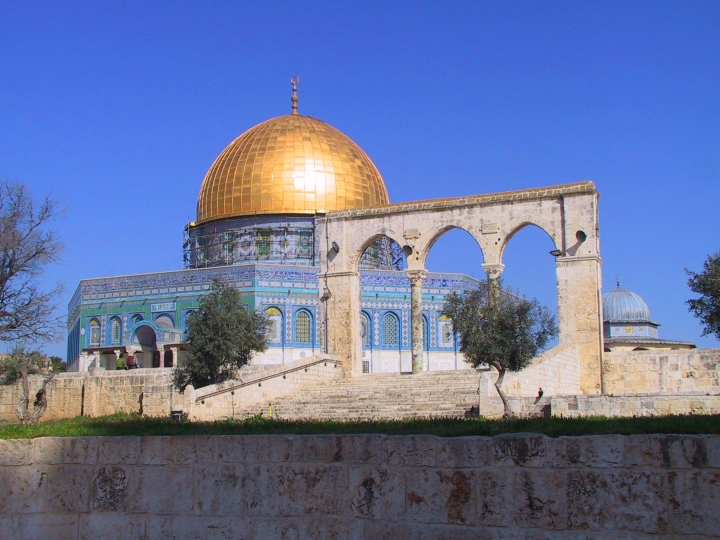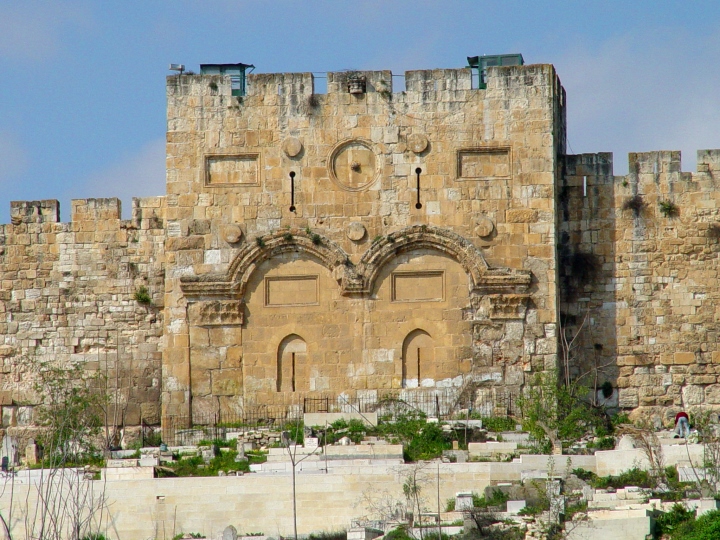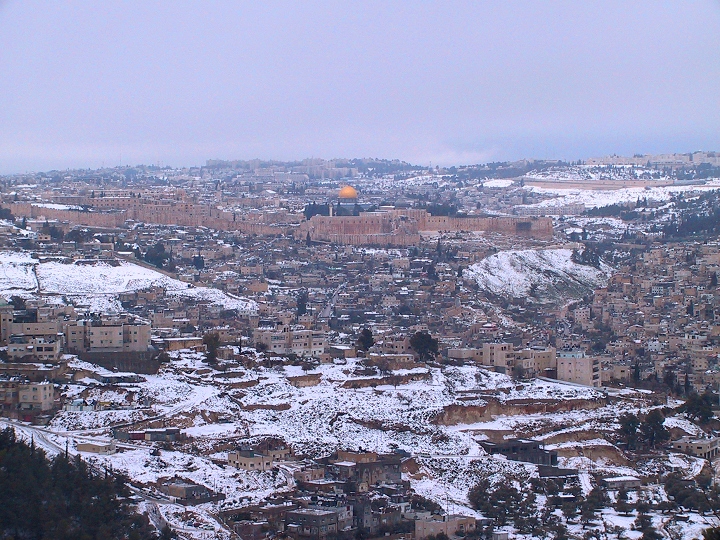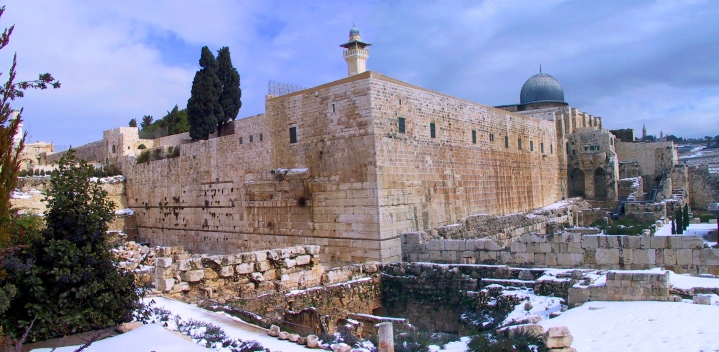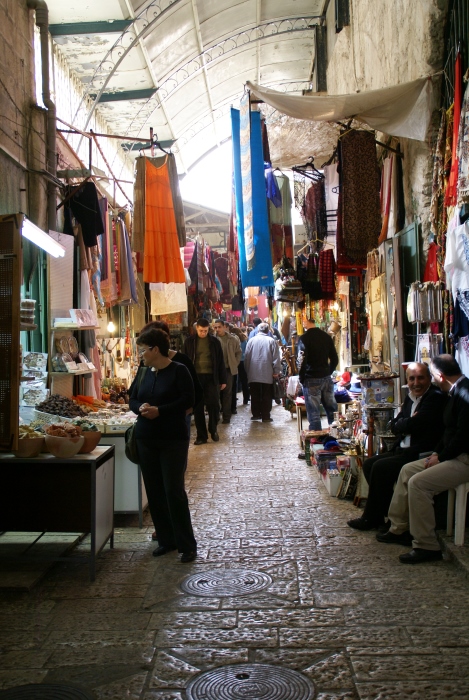Psalms 122:6-8 Pray for the peace of Jerusalem: "May those who
love you be secure. 7 May there be peace within your walls and
security within your citadels." 8 For the sake of my brothers
and friends, I will say, "Peace be within you." (NIV)
There are 804 direct references, by name, (in 760 verses) to the city
of Jerusalem. This article, unlike many others on this site, will not
attempt to exhaustively examine all of them. Rather, consider this a
brief overview of the place where so much of Jewish and biblical
history has been focused.
Jerusalem is physically located on the central mountain ridge of
Israel, in line with the northern tip of the Dead Sea, approximately
58 km (36 miles) east of the Mediterranean and 26 km (16 miles) west
of the Dead Sea.
The earliest mention of Jerusalem appears to be the ancient Canaanite
site of Salem, the city of the priestly king Melchizedek.
Genesis 14:18-19a Then Melchizedek king of Salem brought out bread
and wine. He was priest of God Most High, 19 and he blessed Abram... (NIV)
Beyond Salem, and another ancient name for the city was certainly
"Jebus", its name as a Jebusite city. This appears to have
remained the primary name from the time of the Judges 1
until the time of David, with his taking of the city 3
and turning it into the principal city of Israel.
Judges 19:10 But, unwilling to stay another night, the man left and
went toward Jebus (that is, Jerusalem), with his two saddled donkeys
and his concubine. (NIV)
1 Chronicles 11:4-9 David and all the Israelites marched to Jerusalem
(that is, Jebus). The Jebusites who lived there 5 said to David,
"You will not get in here." Nevertheless, David captured
the fortress of Zion, the City of David. 6 David had said,
"Whoever leads the attack on the Jebusites will become
commander-in-chief." Joab son of Zeruiah went up first, and so
he received the command. 7 David then took up residence in the
fortress, and so it was called the City of David. 8 He built up the
city around it, from the supporting terraces to the surrounding wall,
while Joab restored the rest of the city. 9 And David became more and
more powerful, because the Lord Almighty was with him. (NIV)
It is possible that Israel's knowledge of the earliest name, Salem,
was combined with an ancient word meaning city to become Jerusalem,
"city of peace". For the record, a quick list of the names
of Jerusalem is in order:
-
Salem (Also used as a parallelism with Zion in Psalms 76:2)
- Jebus (See Judges 19:10 and 1 Chronicles 11:4-9 above)
- Jerusalem
- City of David (2 Samuel 5:9, technically only part of Jerusalem)
- Zion (2 Samuel 5:7, Isaiah 60:14, Hebrews 12:22 [END NOTE 2],
Revelation 14:1 [END NOTE 2])
- (Mt.) Moriah (2 Chronicles 3:1, in light of Genesis 22:2)
- The (holy) City (of the Lord) (i.e. Jeremiah 32:24, Psalms 101:8,
Isaiah 48:2, Psalms 48:1,8)
- Ariel (Isaiah 29:1 and additional times in that chapter)
- Aelia Capitolina (when the Romans destroyed Jerusalem, again, in
A.D. 135, the rebuilt city was given this name)
- El-Quds (the name commonly used by Muslims, meaning "the
holy (city)".
- Yahweh is There (A name given to the New Jerusalem, Ezekiel
48:35, in light of Revelation 21:22)
- New Jerusalem (Revelation 21:22, also called the Jerusalem of
above in Galatians 4:26)
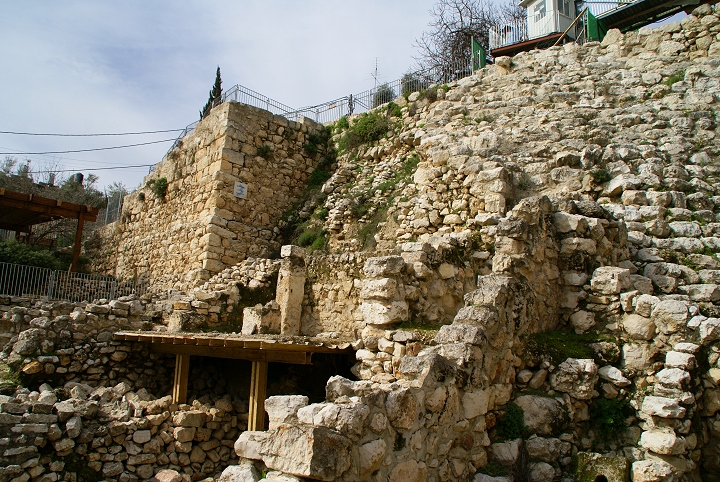
Ruins
of the city of David (Zion)
Jerusalem was the capital of Israel from the time of David onward and
subsequently Judea when the kingdom was divided. It finally, again,
was the capital of all Israel following the Babylonian exile.
Following later rebellions against the Roman, after almost 2000 years
of not being a nation, in an unprecedented fashion Jerusalem is again
the capital of modern Israel following Israel's return to existence
in 1948. Jerusalem was unified in 1967, with the annexation of East Jerusalem.
Perhaps the most enduring claim to fame, for the city of Jerusalem,
is not that it was the capital city but that it was the city of the
temple - the city of the Great God! The first temple was completed by
Solomon, whose reign also saw the city become incredibly wealthy and glorious.
1 Kings 6:1, 7 In the four hundred and eightieth year after the
Israelites had come out of Egypt, in the fourth year of Solomon's
reign over Israel, in the month of Ziv, the second month, he began to
build the temple of the Lord. ... 7 In building the temple, only
blocks dressed at the quarry were used, and no hammer, chisel or any
other iron tool was heard at the temple site while it was being
built. (NIV)
1 Kings 10:26-27 Solomon accumulated chariots and horses; he had
fourteen hundred chariots and twelve thousand horses, which he kept
in the chariot cities and also with him in Jerusalem. 27 The king
made silver as common in Jerusalem as stones, and cedar as plentiful
as sycamore - fig trees in the foothills. (NIV)
This first temple was destroyed, along with much of Jerusalem, when
Israel was taken into captivity by Babylon.
2 Chronicles 36:19-21 They set fire to God's temple and broke down
the wall of Jerusalem; they burned all the palaces and destroyed
everything of value there. 20 He carried into exile to Babylon the
remnant, who escaped from the sword, and they became servants to him
and his sons until the kingdom of Persia came to power. 21 The land
enjoyed its sabbath rests; all the time of its desolation it rested,
until the seventy years were completed in fulfillment of the word of
the Lord spoken by Jeremiah. (NIV)
Without getting into the history of Israel's temples 4,
note that Jesus spent time in Jerusalem and especially at the temple
there. His first visit was as a baby and his second when he was
twelve years old.
Luke 2:22-24 When the time of their purification according to the Law
of Moses had been completed, Joseph and Mary took him to Jerusalem to
present him to the Lord 23 (as it is written in the Law of the Lord,
"Every firstborn male is to be consecrated to the Lord"),
24 and to offer a sacrifice in keeping with what is said in the Law
of the Lord: "a pair of doves or two young pigeons." (NIV)
Luke 2:41-42 Every year his parents went to Jerusalem for the Feast
of the Passover. 42 When he was twelve years old, they went up to the
Feast, according to the custom. (NIV)
Jesus, himself, referred to Jerusalem using language that parallels
prophetic understanding; it is the city of the Great King! It is this
understanding that enables Jerusalem to be representative of God's
people throughout all time.
Matthew 5:34-35 But I tell you, Do not swear at all: either by
heaven, for it is God's throne; 35 or by the earth, for it is his
footstool; or by Jerusalem, for it is the city of the Great King. (NIV)
Even as the people of Jerusalem superficially welcomed Jesus in his
last visit to Jerusalem, which culminated in His crucifixion;
Jesus wept over the city and foretold its destruction and the utter
destruction of the temple.
John 12:12-15 The next day the great crowd that had come for the
Feast heard that Jesus was on his way to Jerusalem. 13 They took palm
branches and went out to meet him, shouting, "Hosanna!"
"Blessed is he who comes in the name of the Lord!"
"Blessed is the King of Israel!" 14 Jesus found a young
donkey and sat upon it, as it is written, 15 "Do not be afraid,
O Daughter of Zion; see, your king is coming, seated on a donkey's
colt." (NIV)
Luke 19:41 As he approached Jerusalem and saw the city, he wept over
it (NIV)
Matthew 23:37-24:2 37 "O Jerusalem, Jerusalem, you who kill the
prophets and stone those sent to you, how often I have longed to
gather your children together, as a hen gathers her chicks under her
wings, but you were not willing. 38 Look, your house is left to you
desolate. 39 For I tell you, you will not see me again until you say,
'Blessed is he who comes in the name of the Lord.'" 24:1 Jesus
left the temple and was walking away when his disciples came up to
him to call his attention to its buildings. 2 "Do you see all
these things?" he asked. "I tell you the truth, not one
stone here will be left on another; every one will be thrown
down." (NIV)
References in the New Testament highlight something only alluded to
in the Old 5, namely that Jerusalem is
also representative of the city of God, the dwelling place for all
believers as the city of the Great King. Paul especially contrasts
the Jerusalem of above with the physical Jerusalem.
Galatians 4:24-26 These things may be taken figuratively, for the
women represent two covenants. One covenant is from Mount Sinai and
bears children who are to be slaves: This is Hagar. 25 Now Hagar
stands for Mount Sinai in Arabia and corresponds to the present city
of Jerusalem, because she is in slavery with her children. 26 But the
Jerusalem that is above is free, and she is our mother. (NIV)
Hebrews 12:22-24 But you have come to Mount Zion, to the heavenly
Jerusalem, the city of the living God. You have come to thousands
upon thousands of angels in joyful assembly, 23 to the church of the
firstborn, whose names are written in heaven. You have come to God,
the judge of all men, to the spirits of righteous men made perfect,
24 to Jesus the mediator of a new covenant, and to the sprinkled
blood that speaks a better word than the blood of Abel. (NIV)
Ultimately this final Jerusalem is know by the name "the new
Jerusalem", the eternal dwelling place of all the saints spoken
about in the final book of the Bible; Revelation.
Revelation 21:2-4 I saw the Holy City, the new Jerusalem, coming down
out of heaven from God, prepared as a bride beautifully dressed for
her husband. 3 And I heard a loud voice from the throne saying,
"Now the dwelling of God is with men, and he will live with
them. They will be his people, and God himself will be with them and
be their God. 4 He will wipe every tear from their eyes. There will
be no more death or mourning or crying or pain, for the old order of
things has passed away." (NIV)
As a last note on the physical city of Jerusalem, take note that it
was the focal point of the spread of the Christ's church 6.
It was from Jerusalem that the message of Jesus has been spread to
the ends of the earth.
Acts 1:8 But you will receive power when the Holy Spirit comes on
you; and you will be my witnesses in Jerusalem, and in all Judea and
Samaria, and to the ends of the earth." (NIV)
|
|
End Notes:
1. While the text refers to the city as Jerusalem
at the time of the Judges it is less certain
if this was what it was called at that time. It is quite probable
that a later official copier of the text applied the updated name,
Jerusalem, to better identify the city for contemporary readers (i.e.
Joshua 10:1-2). The texts where the older name remained seem to have
been intentionally and clearly left to show that there was an earlier
name, now changed to Jerusalem.
Joshua 15:1-8 The allotment for the tribe of Judah, clan by clan,
extended down to the territory of Edom, to the Desert of Zin in the
extreme south. 2 Their southern boundary started from the bay at the
southern end of the Salt Sea,a 3 crossed south of Scorpionb Pass,
continued on to Zin and went over to the south of Kadesh Barnea. Then
it ran past Hezron up to Addar and curved around to Karka. 4 It then
passed along to Azmon and joined the Wadi of Egypt, ending at the
sea. This is theirc southern boundary. 5 The eastern boundary is the
Salt Sea as far as the mouth of the Jordan. The northern boundary
started from the bay of the sea at the mouth of the Jordan, 6 went up
to Beth Hoglah and continued north of Beth Arabah to the Stone of
Bohan son of Reuben. 7 The boundary then went up to Debir from the
Valley of Achor and turned north to Gilgal, which faces the Pass of
Adummim south of the gorge. It continued along to the waters of En
Shemesh and came out at En Rogel. 8 Then it ran up the Valley of Ben
Hinnom along the southern slope of the Jebusite city (that is,
Jerusalem). (NIV)
2. These references utilize the symbolism of
Jerusalem as the city of God or the city of God's people, often
employing the alternate names which were identified with the original
Jerusalem. See end note 5 for some more examples.
3. The men of Judah certainly fought against the
Jebusite city of Jerusalem at the time of the conquests of Joshua. It
appears that they failed to hold the city though as it was clearly
Jebusite up to the time of David.
Judges 1:8 The men of Judah attacked Jerusalem also and took it. They
put the city to the sword and set it on fire. (NIV)
Judges 1:21 The Benjamites, however, failed to dislodge the
Jebusites, who were living in Jerusalem; to this day the Jebusites
live there with the Benjamites. (NIV)
2 Samuel 5:4-10 David was thirty years old when he became king, and
he reigned forty years. 5 In Hebron he reigned over Judah seven years
and six months, and in Jerusalem he reigned over all Israel and Judah thirty-three
years. 6 The king and his men marched to Jerusalem to attack the
Jebusites, who lived there. The Jebusites said to David, "You
will not get in here; even the blind and the lame can ward you
off." They thought, "David cannot get in here." 7
Nevertheless, David captured the fortress of Zion, the City of David.
8 On that day, David said, "Anyone who conquers the Jebusites
will have to use the water shaft to reach those 'lame and blind' who
are David's enemies." That is why they say, "The 'blind and
lame' will not enter the palace." 9 David then took up residence
in the fortress and called it the City of David. He built up the area
around it, from the supporting terraces inward. 10 And he became more
and more powerful, because the Lord God Almighty was with him. (NIV)
4. A quick overview of the structures used
by Israel as a temple is as follows...
-
The Jews had a tabernacle, a tent like structure, which was their
first portable temple. This was built using a design God gave Moses
on Mt. Sinai. Circa 1441 B.C.
-
King David started preparations for, and Solomon built, the first
permanent temple. Circa 958 B.C.
-
The First temple is destroyed. Circa 586 B.C.
-
Decree to build second temple circa 537 B.C.,
completed 515 B.C. (Ezra/Nehemiah etc)
-
King Herod begins a complete rebuilding program on the second temple,
expanding its size. Circa 20 B.C.
Functionally this was a third temple but because the work was not
allowed to interrupt worship at the temple, it's still called the
second temple. This is the temple Jesus visited, for the first time,
in circa 9 A.D., as a boy.
-
The temple is destroyed by the Romans. Circa A.D. 70
5. The Old Testament uses Jerusalem in a prophetic
sense, referencing the city and its temple in regards to end times
and the future home of righteousness.
Isaiah 2:1-4 This is what Isaiah son of Amoz saw concerning Judah and
Jerusalem: 2 In the last days the mountain of the Lord's temple will
be established as chief among the mountains; it will be raised above
the hills, and all nations will stream to it. 3 Many peoples will
come and say, "Come, let us go up to the mountain of the Lord,
to the house of the God of Jacob. He will teach us his ways, so that
we may walk in his paths." The law will go out from Zion, the
word of the Lord from Jerusalem. 4 He will judge between the nations
and will settle disputes for many peoples. They will beat their
swords into plowshares and their spears into pruning hooks. Nation
will not take up sword against nation, nor will they train for war
anymore. (NIV)
Isaiah 52:1-3 Awake, awake, O Zion, clothe yourself with strength.
Put on your garments of splendor, O Jerusalem, the holy city. The
uncircumcised and defiled will not enter you again. 2 Shake off your
dust; rise up, sit enthroned, O Jerusalem. Free yourself from the
chains on your neck, O captive Daughter of Zion. 3 For this is what
the Lord says: "You were sold for nothing, and without money you
will be redeemed." (NIV)
Isaiah 52:4-6 For this is what the Sovereign Lord says: "At
first my people went down to Egypt to live; lately, Assyria has
oppressed them. 5 "And now what do I have here?" declares
the Lord. "For my people have been taken away for nothing, and
those who rule them mock," declares the Lord. "And all day
long my name is constantly blasphemed. 6 Therefore my people will
know my name; therefore in that day they will know that it is I who
foretold it. Yes, it is I." (NIV)
[Consider also Isaiah 52:7-53:12 with its fulfillment in the person
of Jesus Christ.]
Micah 4:1-5 In the last days the mountain of the Lord's temple will
be established as chief among the mountains; it will be raised above
the hills, and peoples will stream to it. 2 Many nations will come
and say, "Come, let us go up to the mountain of the Lord, to the
house of the God of Jacob. He will teach us his ways, so that we may
walk in his paths." The law will go out from Zion, the word of
the Lord from Jerusalem. 3 He will judge between many peoples and
will settle disputes for strong nations far and wide. They will beat
their swords into plowshares and their spears into pruning hooks.
Nation will not take up sword against nation, nor will they train for
war anymore. 4 Every man will sit under his own vine and under his
own fig tree, and no one will make them afraid, for the Lord Almighty
has spoken. 5 All the nations may walk in the name of their gods; we
will walk in the name of the Lord our God for ever and ever. (NIV)
6. In the apostolic era, Jerusalem remained a key
center for the church, especially for the Jewish church. The earliest
church council (Jews and Gentiles) was held there circa 49
A.D.
Acts 15:1-4 Some men came down from Judea to Antioch and were
teaching the brothers: "Unless you are circumcised, according to
the custom taught by Moses, you cannot be saved." 2 This brought
Paul and Barnabas into sharp dispute and debate with them. So Paul
and Barnabas were appointed, along with some other believers, to go
up to Jerusalem to see the apostles and elders about this question. 3
The church sent them on their way, and as they traveled through
Phoenicia and Samaria, they told how the Gentiles had been converted.
This news made all the brothers very glad. 4 When they came to
Jerusalem, they were welcomed by the church and the apostles and
elders, to whom they reported everything God had done through them. (NIV)
|
